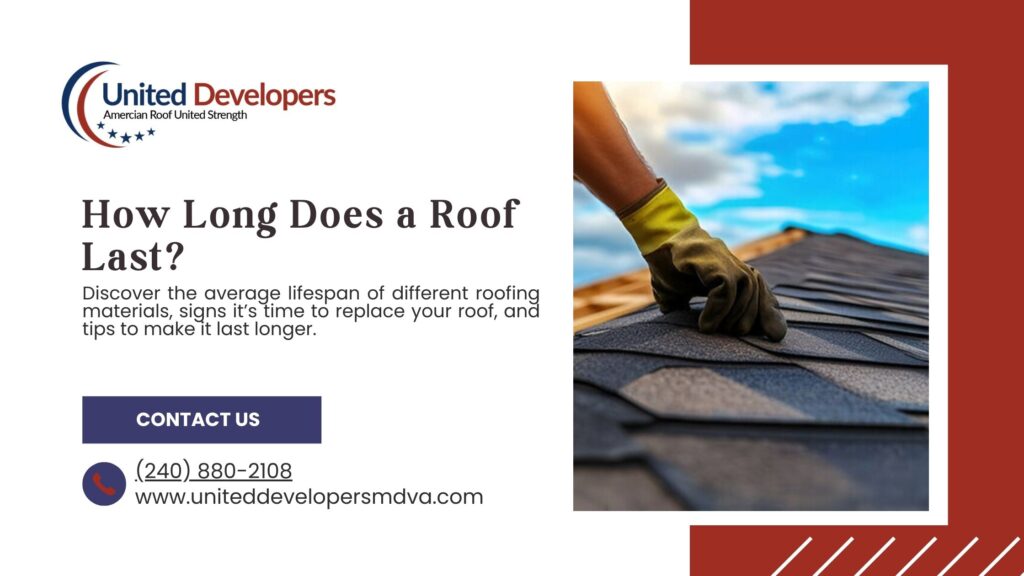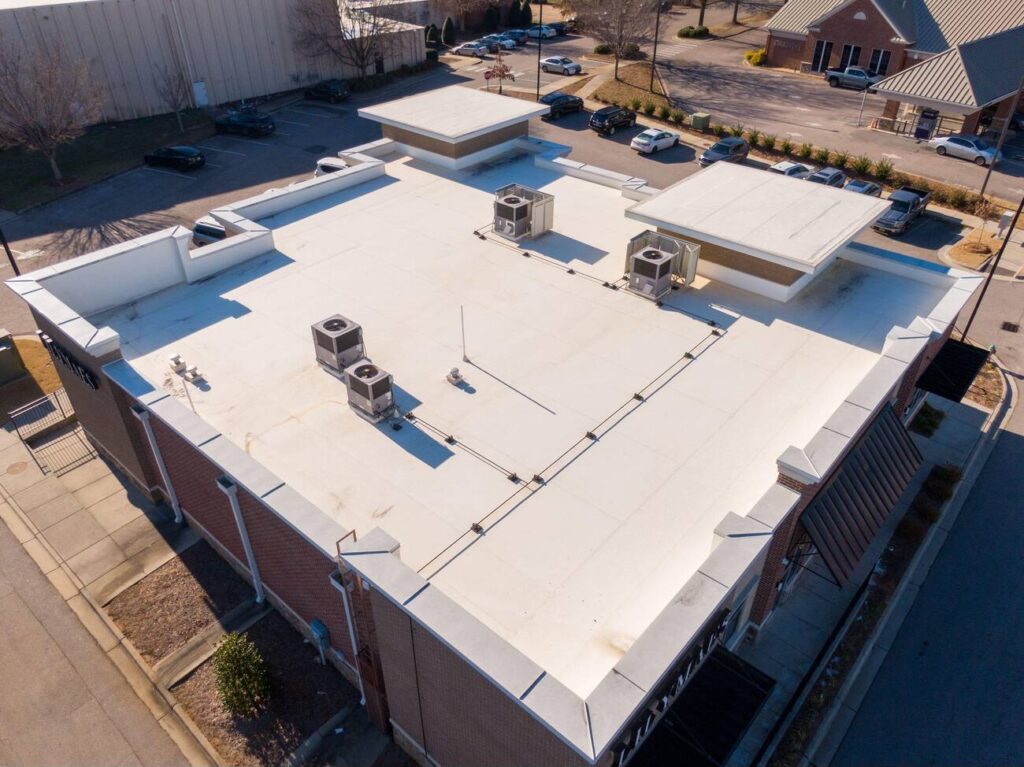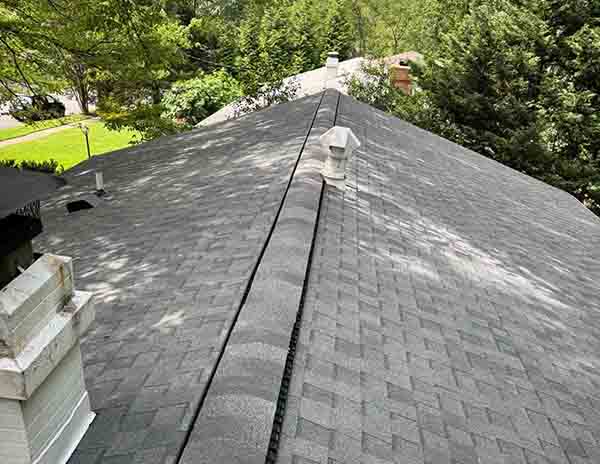Your roof is your home’s first line of defense against the elements. It shields your family from rain, snow, heat, and wind. But like every part of your home, your roof won’t last forever. Eventually, time and weather take their toll, and knowing how long does a roof last helps you plan for maintenance or replacement before serious damage occurs.
So, how long does a roof last? The answer depends on a combination of factors like material, installation quality, climate, and upkeep. In this guide, we’ll explore the average lifespan of different roofing types, what affects durability, and how to make your roof last as long as possible.
Average Roof Lifespan by Material
Not all roofs are created equal. Some materials are affordable and easy to install but have shorter lifespans. Others are costly upfront but can protect your home for decades with minimal maintenance.
Here’s a quick comparison:
| Roofing Material | Average Lifespan | Maintenance Level | Durability |
|---|---|---|---|
| Asphalt Shingles | 15–25 years | Low | Moderate |
| Architectural Shingles | 25–30 years | Low | High |
| Wood Shakes or Shingles | 20–30 years | Medium | Moderate |
| Metal Roofing | 40–70 years | Low | High |
| Clay or Concrete Tiles | 50–100 years | Low | Very High |
| Slate Roofing | 75–150 years | Low | Excellent |
| Flat Roof (TPO, EPDM, PVC) | 20–30 years | Medium | Good |
Asphalt shingles remain the most popular choice for homeowners due to their affordability and ease of installation. However, metal and tile roofing options have grown in popularity for those seeking long-term durability.

Key Factors That Determine How Long Does a Roof Last
Even if you choose the best roofing material, your roof’s actual lifespan can vary depending on several critical factors. Let’s explore the ones that matter most:
1. Quality of Materials
The quality of the materials used has a direct impact on your roof’s lifespan. Cheap shingles or low-grade metal panels may seem cost-effective initially, but they often wear out faster and require frequent repairs. Premium-grade materials provide better resistance against wind, rain, UV rays, and temperature fluctuations.
2. Professional Installation
Improper installation is one of the top reasons roofs fail early. Poorly aligned shingles, loose flashing, or inadequate underlayment can lead to leaks and early deterioration. Choosing an experienced roofing contractor like United Developers ensures your roof is installed correctly with proper sealing and ventilation.
3. Climate and Weather Conditions
Your local climate plays a huge role in roof longevity. Constant exposure to intense sunlight, heavy snowfall, salt air, or high winds can shorten a roof’s lifespan.
- Hot and sunny regions: UV rays cause shingles to dry out and crack.
- Cold and snowy areas: Freeze-thaw cycles can cause expansion and damage.
- Coastal areas: Salt corrosion affects metal and asphalt roofs.
4. Roof Ventilation and Insulation
Proper attic ventilation allows hot air and moisture to escape. Without it, heat buildup can warp shingles, while trapped moisture can lead to mold and rot. A well-ventilated roof stays cooler, lasts longer, and reduces energy costs.
5. Maintenance and Inspections
Even the best roof requires regular upkeep. Cleaning debris, clearing gutters, and inspecting for damage at least once a year can help prevent major problems. Small leaks, if ignored, can lead to costly structural repairs.


Signs Your Roof May Need Replacement
Even the best roof won’t last forever. Watch for:
- Curling or missing shingles
- Leaks and water stains on ceilings
- Loss of granules from shingles
- Sagging rooflines
- Age reaching the material’s limit
If you see these signs, call a roofing expert for inspection.
Roof Longevity by Type
Let’s take a closer look at how long different types of roofs typically last and what makes each unique:
1. Asphalt Shingle Roofs
Asphalt shingles are affordable and easy to install, making them the most common roofing material in the U.S.
Average lifespan: 15–25 years
Maintenance tips: Keep gutters clean and remove moss buildup.
2. Architectural Asphalt Shingles
A more durable version of standard shingles, architectural shingles have multiple layers for added strength.
Average lifespan: 25–30 years
Maintenance tips: Annual inspection and quick repairs after storms.
3. Metal Roofs
Metal roofs are highly durable and energy-efficient. They reflect sunlight and resist fire, wind, and rain.
Average lifespan: 40–70 years
Maintenance tips: Remove debris and check for rust or loose panels.
4. Wood Shakes and Shingles
Wood roofs give a beautiful, natural look but require regular maintenance.
Average lifespan: 20–30 years
Maintenance tips: Treat against rot and insects; ensure proper ventilation.
5. Tile Roofs (Clay or Concrete)
Tile roofs can last a lifetime if properly installed. They resist fire and withstand harsh climates.
Average lifespan: 50–100 years
Maintenance tips: Inspect for cracked tiles and clean debris regularly.
6. Slate Roofs
Slate is one of the most durable materials available. Many slate roofs last over a century.
Average lifespan: 75–150 years
Maintenance tips: Replace broken tiles promptly and inspect flashing.
7. Flat Roofs (TPO, EPDM, PVC)
Flat roofs are common in commercial and modern residential designs.
Average lifespan: 20–30 years
Maintenance tips: Ensure proper drainage to prevent standing water.
When to Replace Your Roof
If your roof is over 20 years old and showing visible wear, replacement might be the best long-term solution. New roofing not only boosts property value but also improves energy efficiency and safety.
United Developers offers professional roof replacement and installation services using high-quality materials and expert craftsmanship. Our team ensures your home stays safe, energy-efficient, and beautiful for years.
Frequently Asked Questions About Roof Lifespan
How long does a shingle roof last?
Most shingle roofs last 15–25 years, depending on quality, weather, and maintenance. Architectural shingles can last up to 40 years.
How long does a metal roof last?
A metal roof can last 40–70 years, with some copper roofs exceeding 100 years if properly installed and maintained.
How can I tell if my roof needs replacing?
Look for curling or missing shingles, leaks, water stains on ceilings, granule loss, or sagging areas. These signs mean your roof may need replacement soon.
Does roof maintenance extend its life?
Yes. Regular inspections, cleaning gutters, repairing minor damage, and proper ventilation can significantly extend your roof’s lifespan.
Which roofing material lasts the longest?
Slate roofing lasts the longest, often 75 to 200 years. Clay and concrete tiles are also highly durable, lasting 50 to 100 years.
How long does a roof last in Maryland?
In Maryland, asphalt shingle roofs typically last 20–25 years. Premium materials like metal or slate last much longer, even in humid or storm-prone areas.
Can I repair a roof instead of replacing it?
Small leaks and damaged shingles can be repaired, but if your roof is near the end of its lifespan, replacement is usually the safer, long-term solution.
How do storms affect roof lifespan?
Heavy rain, hail, wind, and snow can speed up wear and tear. After storms, professional inspections are recommended to catch hidden damage early.
What is the most cost-effective roof that lasts long?
Architectural shingles offer a good balance of cost, durability, and appearance, typically lasting 25–40 years with minimal maintenance.
How often should I inspect my roof?
Homeowners should inspect their roof at least twice a year and after major storms to identify issues before they become serious problems.
Final Thoughts
So, how long does a roof last?
There isn’t a single answer, it depends on your roofing material, installation, climate, and maintenance habits. While asphalt shingle roofs generally last around 20 years, metal, tile, and slate roofs can easily last 50 years or more with proper care.
Investing in professional installation and regular maintenance can double your roof’s lifespan. With the expertise of United Developers, you can rest assured that your roof will stand strong, look beautiful, and perform efficiently for decades to come.


